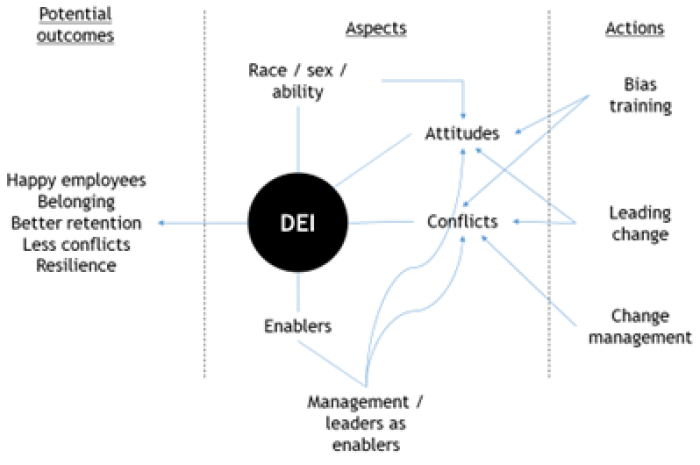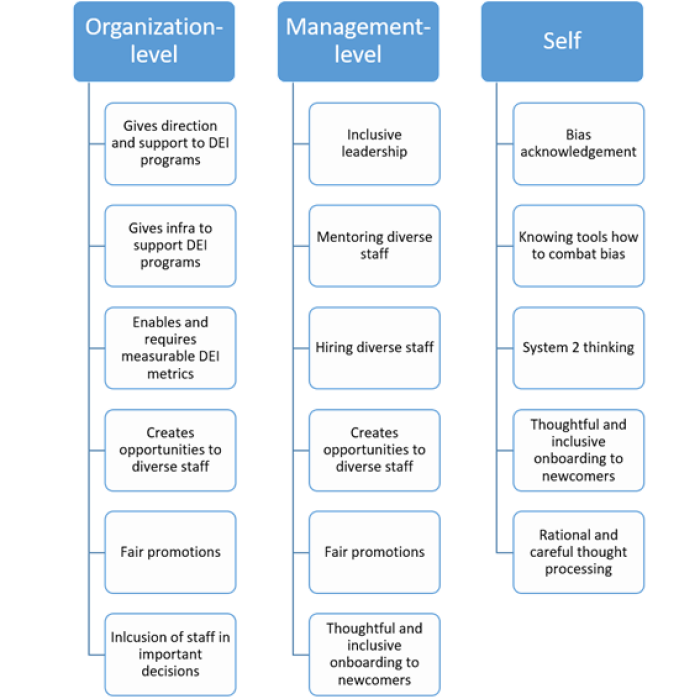In the current employee market, every company seeks to attract and keep good employees. One way to achieve that is to implement diversity, equity, and inclusion (DEI) principles supported by the improvement of leadership and management skills. In order for the implementation to be successful, workers at all levels should become aware of the DEI principles and their own implicit biases. The goal is to ensure that workers feel included, appreciated, celebrated, and like they belong (Bond 2022).
 Photo by Christian Walker on Unsplash
Photo by Christian Walker on Unsplash
Master thesis by Noora Alarauhio investigated how Lindström Finland laundries can improve their worker retention and have a diverse, inclusive, and equitable work environment through modern leadership skills and transformational change. Lindström wanted to improve employee retention in their laundries in Finland because having long careers is an important value for them.
Through qualitative research methods: Semi-structured online video interviews and email questionnaires using the DEI audit tool made by Life Labs it came to light that the case company needs improvements with recruitment & hiring and learning & growth. These are two of the five theme segments in the DEI audit tool. Findings show that business unit directors and laundry heads should be supported by training in inclusion, recruiting interviews, unbiased application processes, and behavioral interviewing techniques. There is also a need for inclusion skills for management and workers in general in addition to regular self-evaluations.
 Figure 1. DEI principles are at the heart of the theoretical framework (Alarauhio 2023, 40).
Figure 1. DEI principles are at the heart of the theoretical framework (Alarauhio 2023, 40).
DEI principles are, therefore, at the centre of the theoretical framework of the thesis and help combat biases, which can be illustrated through System 1 thinking, as seen in Figure 1. System 1 thinking is an evolutionary trait in humans where we can judge a situation and people in seconds and act according to our instincts without needing to think. Change can bring fear in humans; what can happen to them? Preferring things to remain the same is a built-in safety system in humans, the same as System 1 thinking. However, in a working environment, it is often perceived that it is best to use System 2 thinking, as the other side of the coin, which is the rational, methodical, and slower method of making decisions. With System 2 thinking decisions are made with the best knowledge and much thought (Bazerman & Moore 2012).
Below, in Figure 2, is a matrix of responsibilities comprised of the theoretical framework used in the thesis. This matrix indicates that every level of an organization should see its responsibilities in an inclusive workplace and within a DEI program designed to improve DEI matters. As such, successful DEI programs need good regular tracking and measurable short-term and long-term goals. The improvement program should be tied to core business decisions, so they are dealt with regularly. Additionally, they must have an owner from top management to give the program a face (McKinsey & Company and World Economic Forum 2023).
 Figure 2. Matrix of responsibilities comprised of theories from McKinsey & Company (2022), Kim & Roberson (2021), Bourke & Dillon (2013), Kotter (2012), Rossi (2021), Paikeday (2019), and Bond (2022). (Alarauhio 2023, 60).
Figure 2. Matrix of responsibilities comprised of theories from McKinsey & Company (2022), Kim & Roberson (2021), Bourke & Dillon (2013), Kotter (2012), Rossi (2021), Paikeday (2019), and Bond (2022). (Alarauhio 2023, 60).
The thesis concluded also that the case company can extend its knowledge base on DEI matters by getting involved in researching other functions and including all white-collar workers. More data and insights mean the DEI programs can be pinpointed and the results will be amplified.
This paper is based on Noora Alarauhio’s thesis on Creating an inclusive environment by using DEI principles: Case of Lindström laundries. The thesis is part of Laurea’s master’s degree programme in Leading Transformational Change and is an excellent example of relevant practices that companies can use to create an inclusive environment and retain employees. The thesis has a strong theoretical base, complemented with relevant empirical insights, and is oriented towards the promotion of workplace development. The topic is related to the expertise of Noora’s thesis supervisor, Dr. Nikolina Koporcic, who recently published an edited book: Markovic, S., Lindgreen, A., Koporcic, N., & Micevski, M. (Eds.) (2023). Approaches to Corporate Social Responsibility: Knowledge, Values, and Actions. Routledge, covering the topic of inclusion and diversity in some of the chapters.
About the authors:
Noora Alarauhio is an experienced professional in the garment industry. Her expertise ranges from circular economy and garment production to corporate sustainability, and process development. She is currently pursuing an MBA at the Laurea University of Applied Sciences while working as a project manager for Lindström. For her thesis, Noora has delved into the world of leading change and DEI, which she feels are imperative for the future success of companies.
Dr. Nikolina Koporcic (Ph.D. in Economics and Business Administration) is a Principal Researcher at Laurea University of Applied Sciences and an Academy Research Fellow at the Academy of Finland. Nikolina also holds the title of a Docent (Adjunct Professor) at the University of Turku and acts as an Associate Editor of Business Ethics, the Environment & Responsibility Journal. Her research areas include the co-creation of value, open innovation, corporate branding, entrepreneurship, business relationships and networks. In particular, she is studying the importance of Interactive Network Branding for small firms in business markets. Nikolina has published 16 peer-reviewed academic articles, 3 books, 8 book chapters, 22 conference proceedings, and 10 Laurea Journal articles. orcid.org/0000-0001-5050-3819
Reference list:
- Bond, T. 2022. Belonging in the workplace: What does it mean and why does it matter? Accessed 29 July 2023.
- Bourke, J., Dillon, B. 2013. Waiter, is that inclusion in my soup? A new recipe to improve business performance. Research report. Accessed 30 July 2023.
- Kim, J. Y., & Roberson, L. 2021. I’m Biased and So Are You. What Should Organizations Do? A Review of Organizational Implicit-Bias Training Programs. Consulting Psychology Journal: Practice and Research. Advanced online publication. Accessed 17 July 2023.
- Kotter, J.P. 2012. Leading Change. Harvard Business Review Press. Boston Massachusetts. eBook Collection. EBSCOhost. Accessed 28 July 2023.
- McKinsey & Company. 2022. McKinsey Explainers. What is diversity, equity and inclusion? Accessed 16 July 2023.
- McKinsey & Company and World Economic Forum. 2023. Diversity, Equity and Inclusion Lighthouses 2023. Insight report. McKinsey & Company & World Economic Forum. January 2023. Accessed 24 July 2023.
- Paikeday, T.S. 2019. A Leader’s Guide: Finding and Keeping Your Next Chief Diversity Officer. Russel Reynolds. Accessed 10 January 2021.
- Rossi, P. 2021. Konfliktit auttavat ymmärtämään systeemistä muutosta. Tietoasiantuntija-lehti. Nr 5. Accessed 28 June 2023.